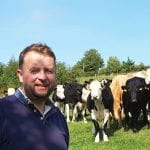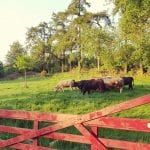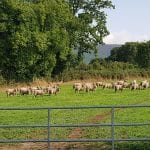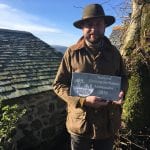Edmund Joyce
Edmund Joyce is a drystock farmer from near Borris in Co Carlow. He was nominated in 2018 for the Farming For Nature Awards. He runs a herd of limousin-cross suckler cows and a flock of commercial Suffolk-cross ewes on the 125 acre holding. Since taking over the farm in 2007 Edmund has planted over 6000 native trees in different newly established groves around the farm. Red squirrels are a regular sight on his farm, and all 15 bird boxes have been occupied each year, even a pair of great spotted woodpeckers took up residence in one of the boxes this year. Both Soprano Pipistrelle bats and Brown Long Eared bats also present in the woodland. Whilst a number of barn owls are particularly attracted to the long grasses in an established wild meadow area and are nesting in the trees. The native apple orchard planted about 7 years ago is providing an abundance of fruit whilst the cottage garden has also been planted up with flowers and shrubs which are a haven for bees, butterflies and hedgehogs. Edmund chose the planting to compliment the setting whilst also providing a succession of plants from early spring right through to winter for nectar feeding insects. Water voles occupy a watercourse which runs the length of the farm whilst the dry-stone granite walls that subdivide the farm have provided ideal cover for other small mammals including stoats and pine martens. Edmund was nominated in 2018 and given the role of honorary ambassador in February 2020.
NOMINATION DESCRIPTION
Edmund Joyce is a drystock farmer from near Borris in Co Carlow. He runs a herd of limousin-cross suckler cows and a flock of commercial Suffolk-cross ewes on the 125 acre holding.
Since taking over the farm in 2007 Edmund has planted over 6000 native trees in different newly established groves around the farm. These plantations comprise of a mix of mainly oak, Scot’s pine, common cherry, alder, rowan and birch with an under-storey of hazel and holly. Young elm trees, propagated from some old elms near the farmhouse have also been planted through this plantation with one of the old Elms believed to be the second oldest Elm in the county.
Pre-established plantations include a stand of Sitka spruce and a smaller stand of European larch. Red squirrels are a regular sight with the presence of the Sitka Spruce a favoured habitat. As part of the GLAS scheme 15 bird boxes and 15 bat-boxes were erected in the wooded area between the farmyard and the farmhouse. All 15 bird boxes have been occupied each year since their arrival and this year a pair of great spotted woodpeckers took up residence in one of the boxes. They widened the bird box entrance holes to suit themselves! Edmund thinks the woodpeckers appear to favour the larch as the bark harbours an abundance of insects. Other woodpeckers are also nesting in the area with Soprano Pipistrelle bats and Brown Long Eared bats also present in the woodland.
Rat poison isn’t laid and this may be an influence in the presence of Barn Owls on the farm. The barn owls are particularly attracted to the long grasses in an established wild meadow area adjacent to the avenue and are nesting in the trees. The native apple orchard planted about 7 years ago is providing an abundance of fruit and that not picked for the house is left for the wildlife. The cottage garden has also been planted up with flowers and shrubs which are a haven for bees and butterflies. Hedgehogs too. Edmund chose the planting to compliment the setting whilst also providing a succession of plants from early spring right through to winter for nectar feeding insects.
Water voles occupy a watercourse which runs the length of the farm. The fencing off of the riparian areas has benefited these mammals as they are offered greater cover. The dry-stone granite walls that subdivide the farm have provided ideal cover for other small mammals including stoats and pine martens. In some areas the tops of these walls have also provided an ideal habitat for establishing a self established run of Bilberrys (Frocans).
(Nomination: Anna Meehan, Project Manager GLAS Traditional Farm Buildings Grant Scheme, The Heritage Council)




